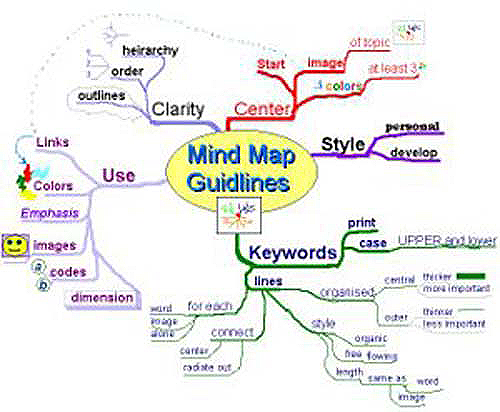Mind mapping in Contrast with Concept Mapping
The mind map can be contrasted with the similar idea of concept mapping. The former is based on radial hierarchies and tree structures, whereas concept maps are based on connections between concepts. Concept maps also encourage one to label the connections one makes between nodes, while mind maps are based on separated focused topics; both of them have been found to enhance meaningful learning while enabling the potential as a true cognitive, intuitive, spatial and metaphorical mapping.
Mind Map Guidelines
These are the foundation structures of a Mind Map, although these are open to free interpretation by the individual:
- Start in the centre with an image of the topic, using at least 3 colours.
- Use images, symbols, codes and dimensions throughout your Mind Map.
- Select key words and print using upper or lower case letters.
- Each word/image must be alone and sitting on its own line.
- The lines must be connected, starting from the central image. The central lines are thicker, organic and flowing, becoming thinner as they radiate out from the centre.
- Make the lines the same length as the word/image.
- Use colours – your own code – throughout the Mind Map.
- Develop your own personal style of Mind Mapping.
- Use emphasis and show associations in your Mind Map.
- Keep the Mind Map clear by using Radiant hierarchy, numerical order or outlines to embrace your branches.

Improving your Mind Maps
Your Mind Maps are your own property: once you understand how to make
notes in the Mind Map format, you can develop your own conventions to
take them further. The following suggestions may help to increase their
effectiveness:
- Use single words or simple phrases for information: Most words in normal writing are padding, as they ensure that facts are conveyed in the correct context, and in a format that is pleasant to read. In your own Mind Maps, single strong words and meaningful phrases can convey the same meaning more potently. Excess words just clutter the Mind Map.
- Print words: Joined up or indistinct writing can be more difficult to read.
- Use color to separate different ideas:
This will help you to separate ideas where necessary. It also helps you to visualize of the Mind Map for recall. Color also helps to show the organization of the subject. - Use symbols and images:
Where a symbol or picture means something to you, use it. Pictures can help you to remember information more effectively than words. - Using cross-linkages:
Information in one part of the Mind Map may relate to another part. Here you can draw in lines to show the cross-linkages. This helps you to see how one part of the subject affects another.
Key points:
Mindmapping is an extremely effective method of taking notes. Mind Maps show not only facts, but also the overall structure of a subject and the relative importance of individual parts of it. They help you to associate ideas and make connections that might not otherwise make.
If you do any form of research or note taking, try experimenting with Mind Maps. You will find them surprisingly effective!